Pittsburgh and Villanova Pose Roadblocks for Syracuse in Big East
Pennsylvania was once known as The Coal State when coal mining was one of its’ leading industries. Regardless of where that stands in the state’s economy today, the Syracuse University men’s basketball team has to wonder if the mines have been rejuvenated over the past decade or so in Pittsburgh and Philadelphia. If they were to investigate, the Orange would probably find Panthers and Wildcats mining the coal.
Big East foes Pittsburgh and Villanova have left Syracuse feeling like one who wakes up Christmas morning and finds just that – coal – in their stocking more times than not. Despite a stellar run of success by the Orange since the 2000-01 season, which peaked with their first and only national championship in 2003, Pittsburgh and Villanova have been a thorn in their side. Syracuse is only 10-23 against the Pennsylvania duo since the 2000-01 season commenced.
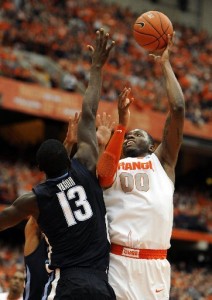
Rick Jackson of Syracuse battles against Mouphtaou Yarou of Villanova on Jan. 22 in the Carrier Dome. Villanova won 83-72. (Richard Mackson/US Presswire)
The coal was evident twice last week for the No. 3 Orange whose undefeated season of 18-0 ended with back-to-back losses to two of their toughest conference foes, both nationally ranked. First came a trip to the Petersen Events Center in Pittsburgh where Syracuse lost to the fifth-ranked Panthers, 74-66 on Jan. 17. Pittsburgh jumped on the Orange early en route to a 19-0 lead. Although Syracuse scored the next 17 points to pull within two, they would never lead in the game which featured just one tie, that coming in the second half.
Five days later on Jan. 22, the Orange hosted No. 7 Villanova in the Carrier Dome before a crowd of 33,736, the second largest on-campus crowd in NCAA college basketball history. Villanova prevailed 83-72 behind a timely shooting display that busted the fabled 2-3 zone of Syracuse. It was Villanova’s 13th win over the Orange in the Dome, the most of any Syracuse opponent all-time.
Two games against ranked opponents in less than six full days and the Orange had been humbled with a pair of defeats, knocking them not only from the ranks of the undefeated and from atop the Big East standings, but causing them to drop in the national rankings. Syracuse had to feel as though a lump of coal had been handed to them not once, but twice. The Orange, ranked third in both the Associated Press and the USA Today/ESPN Coaches Polls on Jan. 17, fell to 10th and ninth in the polls respectively on Jan. 24.
Thus, Pittsburgh and Villanova have been the Achilles heel of Syracuse which has otherwise dominated most of their Big East foes. Since the 2000-01 season, the Orange sports a winning record against 11 of the other 13 teams that currently make up the Big East which expanded to 16 teams for the 2005-06 season.
Louisville and Connecticut are the other teams that Syracuse has a losing record against with marks of 1-5 and 9-10 respectively. However with several thrilling games such as their epic six overtime thriller in the Big East Tournament quarterfinals in 2009 – won by the Orange 127-117 – you can call the series with the Huskies a near draw. Most of the games in the series with Connecticut have been extremely competitive even if one team has won by double figures which has been the case 11 times in the 19 meetings.
On the plus side for Syracuse, they have at least 10 wins over six of the other 11 conference teams with its’ best mark being 13-2 against Rutgers. The Orange is 12-7 over arch rival Georgetown and also has 12 wins apiece over West Virginia and Notre Dame who they are 12-2 and 12-5 against respectively.
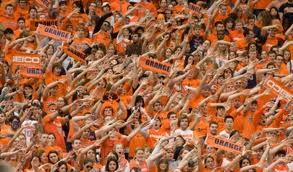
Otto, Syracuse's furry orange mascot, had plenty of support as shown here with Otto's Army waving in orange hysteria against Villanova in the Carrier Dome on Jan. 22.
The domination by Syracuse over their Big East counterparts since 2000-01 can be more clearly seen against some of the original members of the conference which was formed in 1979. The Orange is 11-1 against St. Johns, 11-3 with Seton Hall, and 9-2 against Providence.
Syracuse has won the last five matchups with St. Johns including a 17-point road win earlier this season, its’ third straight win in the series by at least that much. Six of the eleven wins against the Red Storm have been by double digits including a 29-point victory at St. John’s in February of 2009.
The Orange have also owned Seton Hall. Even when the Pirates qualified for the Big East Tournament in 2009, Syracuse beat them by 15 points, 89-74, to advance. The Orange is 6-1 in the last seven games in the series and has won five straight including a 61-56 road win earlier this season. Four of their wins over the last seven meetings have come by 12 or more points.
Similar results have come against Providence as Syracuse is 4-0 at home and 4-2 on the Friars’ home court. The Orange have won the last three meetings including an 81-74 win in their conference opener this year in the dome. Syracuse also swept Providence last season with a 17-point home win followed by a 14-point road win.
The Orange have also piled up the wins over Cincinnati, South Florida, DePaul, and Marquette who all joined the Big East in 2005-06 along with Louisville. Syracuse is 6-2 against Cincinnati and 6-1 against both South Florida and DePaul. The Orange is 4-0 against Marquette, the only team it has never lost to in Big East play among the current conference members.
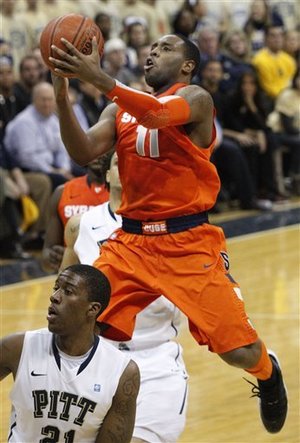
Junior guard Scoop Jardine of Syracuse splits a pair of Pittsburgh defenders looking to make a play on Jan. 17 at the Petersen Events Center. (Keith Srakocic /AP Photo)
All totaled, Syracuse is 122-64 against Big East Teams since 2000-01. Keeping that mark a tad short of a 2:1 ratio of wins to losses is the 10-23 record against Pittsburgh and Villanova that when added to the marks against Louisville and Connecticut makes the Orange 20-38 against those four teams. Thus, Syracuse is 122-26 in Big East play excluding games against Pittsburgh, Villanova, Louisville, and Connecticut over the last decade and into the first seven league games this season.
While the Orange have a national title of their own, three teams of this quartet – Connecticut (2004, ’09), Louisville (2005), and Villanova (2009) – have been to the Final Four since Syracuse cut down the nets and Connecticut has won a national title, that coming in 2004. When Villanova went to the Final Four in 2009, it had to beat Pittsburgh to get there in a memorable NCAA East Regional Final. The Wildcats’ Scottie Reynolds drove the length of the court to score the winning basket in the closing seconds. Yes, even the roadblocks of the Orange have had to beat one another to get to the promise land.
Yet, some teams just have your number and that has been the case for Syracuse with Villanova and Pittsburgh. Including this season’s win, the Wildcats have won six of the last eight meetings with the Orange, three coming in the dome. Furthermore, Villanova is 4-2 in its’ last six trips to the dome dating back to 2006.
That year, the Wildcats played spoiler to a then-NCAA on campus record crowd of 33,633 that packed the dome to see the final regular season home game in the illustrious career of four-year starting guard Gerry McNamara, the school’s all-time leader in 3-point field goals made with 400. McNamara did not disappoint on senior day, scoring 29 points in the regular season finale before a national television audience on CBS. He converted five 3-point field goals in the game to become the Big East’s career 3-point field goal leader with 183. Yet, the fourth ranked Wildcats beat Syracuse 92-82.
Villanova has also beaten the Orange when the stakes are high, winning the last two Big East Tournament encounters with Syracuse. The Wildcats won 78-64 in a first round match up in 2002 and posted an 82-63 win in another first round game in 2008. That 2008 win factored into the Orange missing the NCAA Tournament for the second straight year as Syracuse went to the NIT.
However, the Orange have not been totally shutout by the Wildcats. It was just last season that they beat Villanova rather easily in a highly anticipated match up of nationally ranked teams. On Feb. 27, 2010 fourth-ranked Syracuse beat No. 7 Villanova 95-77 in front of 34,616 fans, an NCAA on-campus attendance record for a college basketball game.
The win catapulted the Orange into the top spot in both the AP and USA Today/ESPN Coaches Poll two days later on March 1. It was the first No. 1 ranking for Syracuse in the regular season since the 1989-90 campaign when they were No. 1 in the AP Preseason Poll and held that spot into the first week of January.
Playing on live national television so much via the ESPN family of networks and CBS, the Orange have been in the national spotlight on a regular basis for so many years. Success and recognition have followed naturally like Syracuse fans flocking to the merchandise shops on Marshall Street, a popular location on the hill of the Orange. Syracuse head coach Jim Boeheim, a 2005 inductee into the Naismith Memorial Basketball Hall of Fame, has guided talented teams over this time that have produced many professional players.
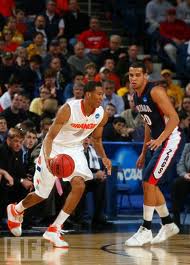
The Big East Player of the Year in 2010, Wes Johnson was a vital part of a Syracuse team that climbed to No. 1 in the country on March 1, 2010 for the first time in 20 years.
Carmelo Anthony, Hakim Warrick, McNamara, Demetris Nichols, Donte Greene, Jonny Flynn, Wes Johnson, and Andy Rautins all reached the professional ranks with Anthony currently one of the top players in the NBA with the Denver Nuggets. In his one magical season in Orange, Anthony garnered a boat load of honors including the most outstanding player of the Final Four en route to leading Syracuse to the national title with a thrilling 81-78 win over Kansas on Apr. 7, 2003. A unanimous pick as the Big East Rookie-of-the-Year, Anthony was also a consensus pick to the Big East All-Rookie Team.
Named a First-Team All-American by The Sporting News and tabbed the national Freshman-of-the-Year by the United States Basketball Writers Association, Anthony was a First Team All-Big East selection becoming the second ever freshman to be so honored joining former Orange standout Dwayne “Pearl” Washington. Statistically, Anthony scored in double figures in all of Syracuse’s 35 games that season, leading the Orange in scoring 24 times.
Other players have garnered plenty of accolades as well. Warrick was a first-team AP All-American selection as a senior in 2005, only the fourth Syracuse player ever so honored and the first since Billy Owens in 1991. In addition, Warrick was a First-Team All Big East selection, the Big East Player-of-the-Year, and won the Dave Gavitt Award as the Most Valuable Player of the Big East Tournament, all as a senior. Warrick is a testament to the credibility of the Orange program as he steadily improved each of his four years, earning the Big East’s Most Improved Player honor following his sophomore year in 2003.
McNamara was also a First-Team All Big East selection in 2005 and was chosen to the Big East All-Tournament Team. The following year, McNamara repeated as a First-Team all conference pick and won the Gavitt Award as the Big East Tournament MVP. McNamara’s epic performance – including two three-pointers to win or extend games in the closing seconds against Cincinnati and No. 1 Connecticut – over four days in Madison Square Garden was perhaps the best display of courage and theater since that fabled Duke-Kentucky game in the 1992 NCAA East Regional Final, won by Duke on Christian Laettner’s game-winning buzzer beater.
Syracuse received more accolades during the 2009-10 season which opened with Boeheim logging his 800th career win with a 75-43 home win over Albany. Johnson, a junior forward, was the Big East Player-of-the-Year as the Orange set a school record with 28 regular season wins. With a 15-3 conference mark, Syracuse won the Big East regular season title outright for
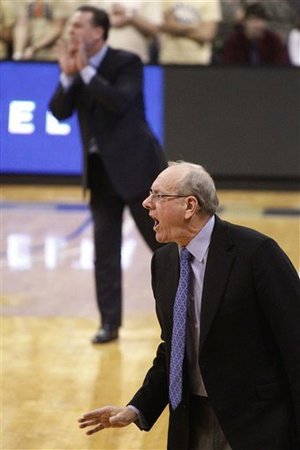
Syracuse head coach Jim Boeheim (foreground) and Pittsburgh head coach Jamie Dixon call out to their respective teams on Jan. 17 in Pittsburgh. (Keith Srakocic /AP Photo)
just the second time in Boeheim’s tenure. Boeheim was also named the national Coach-of-the-Year by The Sporting News and Fox Sports.Com.
While the Orange have had so many outstanding players, Villanova has had its share as well. Kyle Lowry, Randy Foye, Allan Ray, and Mike Nardi were all on the team that beat Syracuse in McNamara’s farewell game in the dome in 2006. Guard Scottie Reynolds was a clutch performer and shooter. Frontcourt players like Dante Cunningham, Shane Clark, Curtis Sumpter, and Dwayne Anderson have been key for Villanova. Furthermore, the Orange saw last weekend what the likes of Corey Fisher, Corey Stokes, and Maalik Wayns can do from beyond the arc as they combined to make 10 3-point baskets.
Like those great players, Pittsburgh has also had its share of top performers. In the early part of the decade, Pittsburgh had the likes of Julius Page and Brandin Knight leading the Panthers in the backcourt. Later came the likes of Carl Krauser and Levance Fields at the guard spots. Along the front line have been rugged physical performers like Chevon Troutman, Ontario Lett, Chris Taft, Aaron Gray, Sam Young and DeJuan Blair.
Most if not all of these players have been part of Pittsburgh teams that have played in seven of the last 10 Big East Tournament Championship games. While the Panthers are only 2-5 in the title game, they have gone down leaving it all on the court. Interestingly, Syracuse and Pittsburgh have split their only two meetings in the Big East Tournament during this time.
The Panthers have also had shooters like Ronald Ramon. This has given Pittsburgh the balance between solid perimeter and good interior scoring, problematic for zone teams like the Orange. Combine that with a hard-nosed mentality on defense along with a gritty coach in Jamie Dixon and the Panthers have been nearly as blue-collar as you can get. They are a symbolic reflection of the city they represent which has helped them pile up wins over Syracuse.
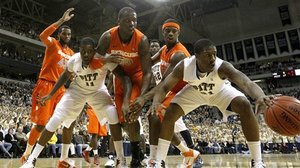
The physical nature of both teams is on display here as a trio of Syracuse players led by Rick Jackson in the middle battle with #11 Dante Taylor (to left) and #21 Lamar Patterson (right side) for the loose ball on Jan. 17. (Keith Srakocic /AP Photo)
That combination has paid off for Pittsburgh as the Panthers have won the last five meetings in the series with the Orange including the win at home on Jan. 17. With that being the only meeting this regular season, Pittsburgh will take an eight-game regular season winning streak against Syracuse into next season. Furthermore, the Panthers are 6-2 in their last eight trips to the dome and have beaten the Orange five straight times on the court that bear’s Boeheim’s name. That has to make Orange fans frown.
Yet, like with Villanova, Syracuse has had some timely wins against Pittsburgh. The last time the Orange beat the Panthers was on March 11, 2006 with a 65-61 win in the Big East Tournament Championship game which gave Syracuse an automatic bid to the NCAA Tournament. The Orange had entered the tournament with three straight conferences losses to end the regular season at 19-11 and 7-9 in the Big East.
Seeded ninth in the Big East tournament, Syracuse faced the prospect of possibly needing to win the tourney title to receive an NCAA Bid. The victory over Pittsburgh made the Orange the first team to capture the tournament title by winning four games in four days.
So when the stakes have been high against the Panthers, Syracuse has responded. Such was the case on two other occasions against Pittsburgh. One came in 2004, when the Orange posted a 49-46 overtime win over the No. 3 Panthers in the Petersen Events center. It is Syracuse’s only ever win in the facility where they are 1-5 and have lost their last four times there.
The win enhanced the postseason chances for Boeheim’s team, ended Pittsburgh’s 40-game home court winning streak, and marked the first time that any opponent had won in the facility since it opened prior to the 2002-03 season. McNamara scored five of the first seven points in the extra session for the Orange including his only field goal of the game, a 3-pointer with 3:53 left to play to help Syracuse post the upset.
The other close game with the Panthers came a year earlier during the national championship season of 2002-03. Hosting No. 2 Pittsburgh on Feb. 1, 2003, the Orange rallied to win 67-65. It was the first time that Syracuse beat a No. 2 team since upsetting Georgetown 82-76 in overtime on March 5, 1989 in the dome.
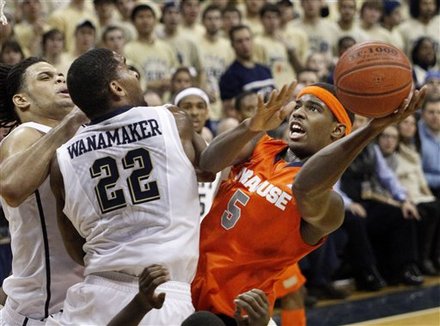
Syracuse's C.J. Fair maneuvers around Pittsburgh's Brad Wanamaker to get off a shot against the Panthers on Jan. 17.
Trailing 65-61 with 1:43 left, the Orange scored the last six points to win it. A desperation 3-point heave by Knight with 0.8 seconds left went in, but it was ruled no good after it was determined to have been released after the buzzer.
So again, like with Villanova, Syracuse has posted some big and timely wins against the Panthers. They have just been few and far between. Regardless, these few wins by the Orange are not to be forgotten. After all, Syracuse has been among the elite in the Big East for a long time and you just don’t go away due to a drought or two, even if it is against the better or best teams in your conference.
So even if the Orange have gotten coal from their recent encounters with Pittsburgh and Villanova, it doesn’t mean they’ll continue to get it. The wins they have had in the past offer hope for the future.
Syracuse’s first chance to realize that hope comes in Philadelphia on Mon. Feb. 21 when they face Villanova for a second time this season. The 7 pm game will be part of ESPN’s Big Monday. Enough said.
Credits: Syracuse University Athletics web site (www.suathletics.com).
What’s up, I want to subscribe for this weblog to take most up-to-date updates, so where can i do
it please assist.